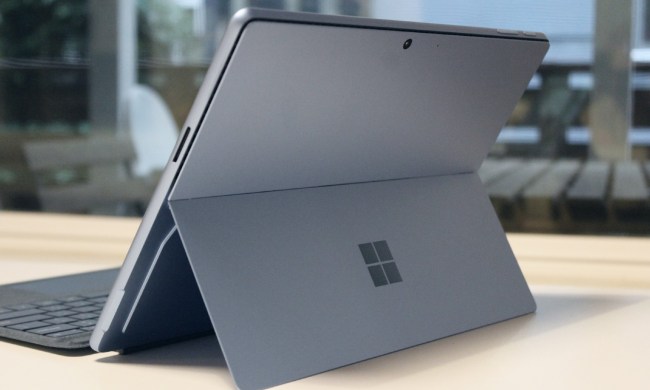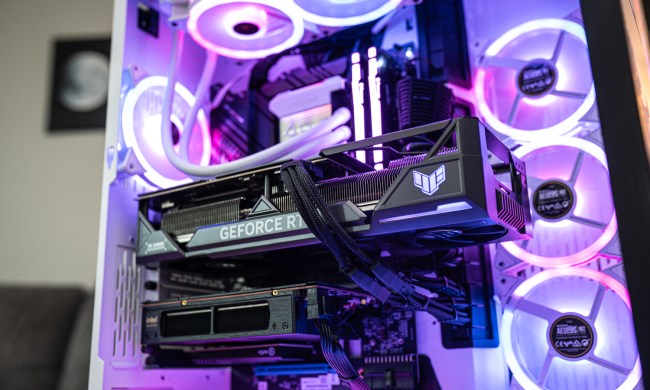“The WNDR3700 offers an impressive collection of features and very good performance...”
- True dual band (2.4- and 5GHz); fast throughput; great feature set; attractive
- Pricey; can't share a printer over the network
Summary
Netgear’s WNDR3700 has all the features we’ve come to expect from high-end routers, including a dual-band radio that enables you to operate two networks on different frequency bands, a USB port for attaching shared storage, the ability to establish a guest network (two, in fact), and, of course, support for the IEEE 802.11n standard. But the WNDR3700 also has a few features that we haven’t seen in any router, including the ability to monitor and even limit the amount of data that can be downloaded from or uploaded to the Internet, a valuable benefit if your Internet service provider caps your bandwidth and charges you for exceeding that cap. Still, there’s one feature that’s missing: The ability to share an attached printer over a network.
Features
Being a dual-band router, the WNDR3700 features two separate radios: One operates on the increasingly crowded 2.4GHz frequency band and the other works on the relatively open 5GHz band. This enables you to establish two wireless networks that won’t compete with each other for bandwidth.
Why would you need two networks? Most people use the 2.4GHz network to carry their data traffic and to handle the bulk of their Internet access, reserving the 5.0GHz network for streaming audio and video from a PC, NAS (Network Attached Storage), or home server to a home theater PC or other media adapter. We describe the 2.4GHz frequency band as increasingly crowded because that’s the frequency on which most wireless routers—old and new—operate. Many cordless phones, wireless baby monitors, and even microwave ovens also emit signals at this frequency.

But having a dual-band router has advantages as, even if you don’t stream media, there are only 11 channels on the 2.4GHz frequency band that are available for wireless networking, and only three of those (channels 1, 6, and 11) don’t overlap. A router can boost its throughput by bonding two of those three non-overlapping channels together, but that leaves only one non-overlapping channel for any other wireless access points operating in the same vicinity. Routers complying with the 802.11n standard are therefore required to support what’s called a good-neighbor policy in which the router will automatically turn off channel bonding if it detects another wireless router operating nearby.
The 5GHz frequency band, on the other hand, can support 12 non-overlapping channels in the U.S. (23 channels worldwide), which greatly reduces the risk of access-point conflict even when channel bonding is enabled. The one drawback to operating access points on the 5GHz band is that they typically have shorter range.
In addition to operating two conventional wireless networks, the WNDR3700 also supports guest networks on each frequency band. This is a great feature to have if you frequently entertain visitors with laptops or Wi-Fi enabled cell phones because you can grant them access to your Internet connection, either with or without a password, while locking them out of any other computers on your network. This router also goes further than other models we’ve seen that support guest networks in that it gives you the option of strictly limiting guests to Internet access or allowing them to access other computers operating on the guest network.

The WNDR3700 supports three wireless network configurations, described as “Up to 54Mb/s,” “Up to 130Mb/s,” and “Up to 300Mb/s.” Translation: You can establish a network that can handle 802.11b and 802.11g clients only, delivering up to 54 megabits per second; one that can handle 802.11b, -g, and –n clients—without using channel bonding—to deliver throughput up to 130 megabits per second; or a network that does use channel bonding, is limited to 802.11a and –n clients, and can deliver throughput up to 300 megabits per second. The router’s 2.4GHz radio defaults to “Up to 130Mbs” mode, while it’s 5GHz radio defaults to “Up to 300Mbs mode.”
This router also supports Wi-Fi Protected Access, a standard feature that Netgear calls Push ‘N’ Connect. This means you can connect a client to the network simply by pressing one button on the router and one button on your computer’s wireless adapter. The router supports all the typical security protocols (WEP, WPA, WPA2) as well as WPA/WPA2 Enterprise (for corporate environments).
The WNDR3700 features a Universal Plug-n-Play (UPnP) server to support media-streaming devices, such the Sonos Digital Music System and the Logitech Squeezebox, but it also has a DLNA (Digital Living Network Alliance) server to support gaming consoles such as the Xbox 360 and the PlayStation 3 and upscale A/V receivers, such as the Onkyo HT-RC180.
Netgear’s traffic meter feature is useful to the extent that it can prevent you from exceeding whatever bandwidth cap your ISP has slapped on you, but it falls short in that it can’t police bandwidth consumption on a per-client basis. So if your teenager has their own PC and are constantly downloading movies from BitTorrent sites, this feature won’t stop him or her from sucking up all your allotted bandwidth.
Benchmark Performance
Windows computers use the TCP/IP protocol to transfer files over a network, so we measured the WNDR3700’s TCP/IP throughput using the J/Perf benchmarking tool. We tested the router’s 2.4GHz radio operating in 802.11a/n mode with channel bonding enabled and used Netgear’s dual-band WNDA3100 USB wireless Ethernet adapter in the client laptop. We used a Linksys WRT600n wireless router as our basis of comparison becuase it’s the fastest router we’ve tested to date.
We measured TCP/IP throughput in three locations inside a custom-built 2800 square-foot home and three locations outside it. At close range, with the client located in the home’s kitchen (20 feet from the router, separated by an insulated wall and a set of plywood cabinets), the router delivered an impressive throughput of 102 Mb/sec (megabits per second). That’s nowhere near the promised 300Mb/sec, of course, but that’s to be expected; 300Mb/sec is a theoretical maximum that doesn’t take into account factors such as TCP/IP throughput. Real-world throughput of 102Mb/sec is very fast (the Linksys WRT600N delivered the same throughput).
Our second indoor test takes the client into the home’s master bedroom. This spot is 60 feet from the router, separated by two insulated interior walls and one set of plywood cabinets. The WNDR3700’s 41.2Mb/sec throughput is comparable to the WRT600N’s 38.3 Mb/sec.

Our final indoor test location, inside a home theater, presents a significant obstacle for wireless routers because of the room’s construction. This is a room-within-a-room design, which delivers great acoustics and reduces the leakage of sound to other rooms in the house, but most wireless routers have a tough time penetrating it.
We had the room framed with 2x6s with one layer of drywall on the exterior, and then built a second framing wall of 2x4s inside it. The two framing walls are separated by two inches, leaving a total of eight inches of dead space. This cavity is stuffed with two thicknesses of R19 fiberglass insulation. The second interior wall and the ceiling are covered with two layers of drywall, with acoustic caulk sandwiched between the layers.
At this point, the client is 35 feet from the router, and the signal must pass through three insulated interior walls and two sets of plywood cabinets before it hits the exterior of the home theater. Wireless throughput dropped to 41.8Mb/sec here, but that’s much better than the WRT600N’s performance of 31.6Mb/sec.
We then moved the client onto our enclosed patio for the first of our outdoor tests. This puts the client 38 feet from the router, separated by an insulated interior wall with plywood cabinets and one insulated exterior wall, which is sheathed in fiber-cement siding. The Netgear delivered throughput of 55.2Mb/sec, which was significantly slower than the WRT600N’s 80.6Mb/sec.
Our remaining outdoor tests were conducted at much greater distances. The first location was 90 feet from the router, but at an oblique angle so that the signal must pass through just one insulated interior wall with a set of plywood cabinets and one insulated exterior wall. The WNDR3700 achieved throughput of just 1.5Mb/sec here, compared to 2.4Mb/sec for the WRT600N. The Netgear trounced the Linksys in our second test, though, where the client was 85 feet and at a right angle to the router. Even with the signal passing through more obstacles—four insulated interior walls, one insulated exterior wall, and a set of plywood cabinets—the WNDR3700 delivered impressive throughput of 4.8Mb/sec, clobbering the Linksys, which managed just 0.4Mb/sec.
Conclusion
The WNDR3700 offers an impressive collection of features and very good performance, with average TCP/IP throughput of 60.1Mb/sec compared to the Linksys WRT600N’s average of 63.1Mb/sec. (We excluded the two long-distance measurements to calculate average throughput.) Router manufacturers seem bent on producing routers that blend into your décor by hiding their antennas inside their enclosures, but this is the first model we’ve tested that didn’t trade performance for appearances. Bravo, Netgear. We dig the guest network, Quality of Service, traffic meter, and storage features, too. However, we’re surprised that Netgear didn’t also include printer sharing.
Pros:
- Fast throughput
- Operates on both 2.4- and 5GHz frequency bands
- Supports two guest networks
- Pretty industrial design
Cons:
- Expensive
- Doesn’t support network printer sharing


